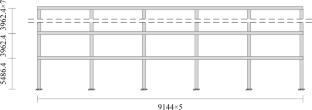An efficient method based on shear models for structural seismic response prediction considering hysteretic characteristics
Abstract
A novel and efficient method based on shear models considering hysteretic characteristics is proposed for predicting structural seismic responses. This method simplifies an actual building by representing it as a lumped mass shear model, with a set of tunable parameters allocated to the interstory restoring force model of each floor. The shear model is calibrated by matching the cyclic interstory pushover curves between the equivalent inelastic spring of each floor and the refined beam–column element model using a metaheuristic optimization algorithm. The novelty of the proposed method lies in its consideration of both cyclic envelopes and hysteretic characteristics (stiffness and strength deterioration and pinching behavior) and its automatic parameter calibration. Validation of the parameter calibration procedure is performed by comparing it with empirical methods via the application on three lateral load tests of reinforced concrete (RC) columns that exhibit varying degrees of hysteretic degradation. The efficiency and accuracy of the proposed method are confirmed through four illustrative examples, including the seismic response predictions of a bare RC frame, two steel frames, and an infilled wall RC frame. Despite the relatively large errors in the acceleration response predictions, the results demonstrate that the proposed method can accurately and efficiently predict the displacement and velocity responses.



 求助内容:
求助内容: 应助结果提醒方式:
应助结果提醒方式:


